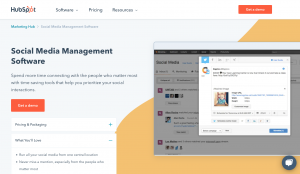
Social (media) listening is finding out about your audience through different means, such as monitoring social media and tracking what people do on the web. You can create more effective marketing campaigns if you know your target audience’s interest and what kind of content they like. Other advantages include gathering customer feedback on a product or service, and what employees and vendors have to say about you as a company. This article highlights some of the benefits brands can get from listening to social media.
Social media sentiment analysis is an important component of social media listening since it enables you to understand and interpret your performance and that of your competition. Rather than simply counting how many times your company is referenced on social media, consider what you can learn from social conversations to achieve meaningful business results. Being aware of changes in social attitude helps you to react quickly to unanticipated developments that affect your brand.

What is Social Listening?
Social (media) listening is the process of keeping an eye on and analysing conversations and trends in different parts of the media landscape to find opportunities for your brand and develop tactical plans for it. Social listening can help you learn more about your existing target audience, figure out their likes and dislikes, and create more exciting content that will keep bringing in new followers. Social listening can also provide insights to help you expand to new markets and introduce you to new segments.
If you want to stay on top of the latest marketing trends and stay ahead of the curve, you might want to invest in social listening.
Here are some interesting stats –
✓ 53% of marketers use social listening to identify opportunities for engagement with their audience. (Hootsuite)
✓ 51% of marketers use social listening to understand their audience better. (HubSpot)
✓ 49% of marketers use social listening to measure the success of their marketing campaigns. (Hootsuite)
✓ 43% of marketers use social listening to track the competition. (HubSpot)
✓ 37% of marketers use social listening to monitor their brand reputation. (Hootsuite)
✓ 29% of marketers use social listening to identify influencers. (HubSpot)
✓ 26% of marketers use social listening to generate leads. (Hootsuite)
✓ 18% of marketers use social listening to conduct market research. (HubSpot)
Make The Most of Social Media Listening
Brands have known for a long time that they can use social media listening as a tool in their marketing plan. They say that listening is a virtue and brands can apply this adage – it keeps them aware and most importantly grounded.

Marketers for the past decade have invested in social, and thanks to the availability of various martech platforms, it is now easier to gather and process meaningful information.
The Coca-Cola Company has been using social listening to discover what consumers (and even non-consumers) are talking about on social media and using information that accentuates their marketing strategy. For example, when Coca-Cola released a new flavour of Fanta in Japan. It knew that social media would be a big part of the conversation. It also made sure to post photos and videos of people engaging with the brand – drinking Fanta, which made people feel like they owned the product and made it easier for them to tell their friends about it.
Ford Motor Company is another great example. The company knew that people were talking a lot on social media about electric cars.
Popular Social Listening Platforms
Set up keyword monitoring to capture mentions. Social interactions in HubSpot get linked to contacts in your database, so you prioritise contextual conversations.

HubSpot can be used for social listening by tracking brand mentions, industry trends, and customer sentiment on social media. HubSpot’s social media monitoring tool allows users to track brand mentions on social media platforms like Twitter, Facebook, and Instagram. Users can set up custom streams to monitor specific keywords, hashtags, or competitors, and receive real-time alerts for new mentions. HubSpot uses machine learning algorithms to analyze the sentiment of social media mentions, such as positive, negative, or neutral. This information can help users to identify potential issues or opportunities and respond accordingly.
HubSpot’s social media engagement tool allows users to respond to social media mentions and messages directly from the platform. Users can also assign tasks and collaborate with team members to resolve issues and improve customer satisfaction.
HubSpot’s social media listening tool allows users to monitor industry trends and customer conversations on social media. Users can track popular topics, hashtags, and keywords to identify emerging trends and stay ahead of the competition. HubSpot’s social media reporting tool provides users with detailed analytics on social media performance, including engagement, reach, and sentiment. Users can track the effectiveness of their social media campaigns and make data-driven decisions to improve their results.
Stay insights-driven and gauge the sentiments of your audience. Develop reports based on data from your brand, competitors, and industry topics.

Marketers can use Mention to track their brand mentions on social media and other online platforms. They can monitor conversations and respond to customer queries and feedback in real-time, thereby enhancing their brand reputation and customer satisfaction.
Mention allows marketers to track their competitors and stay up-to-date with their latest marketing strategies and tactics. Marketers can analyze their competitor’s social media activity, content, and engagement metrics to gain insights into what’s working for them and improve their own marketing strategy.
Monitor trends, respond to queries, and amplify positive mentions with Hootsuite.

Hootsuite software simplifies social media management by allowing users to manage multiple social media accounts, schedule posts, monitor brand mentions, analyze social media performance, engage with their audience, and listen to social conversations. By using Hootsuite, users can save time, increase efficiency, and improve their social media marketing efforts.
Hootsuite’s monitoring feature allows users to track their brand mentions on social media in real-time. Users can monitor specific keywords, hashtags, and competitors, and receive alerts when their brand is mentioned.
Sprout’s Listening tool help brands extract actionable insights, and improve brand health by smartly tapping into conversations online.

Sprout Social is a social media management and analytics tool that can help brands to manage their social media presence, engage with their audience, and measure the performance of their social media campaigns.
Sprout Social allows brands to manage all their social media accounts from one platform, schedule posts, monitor conversations, and respond to comments and messages in real-time. This can help brands to save time and stay organized while maintaining an active social media presence. With Sprout Social, brands can engage with their audience by responding to comments, messages, and mentions on social media. They can also use the platform to identify influencers and brand advocates and build relationships with them.
Sprout Social provides detailed analytics and reporting on social media performance, including metrics such as engagement, reach, and impressions. This information can help brands to track the effectiveness of their social media campaigns and make data-driven decisions.
Most importantly, Sprout Social allows brands to monitor social media conversations and mentions related to their brand, products, or services. This can help them to stay on top of customer feedback, identify trends, and respond to any negative feedback in real-time.
Spot controversial conversations before they escalate. Brand24 tracks the volume of discussion around your brand.

Brand24 is a social media monitoring and analytics tool that helps brands to track mentions of their brand, products, or services across various social media platforms, blogs, forums, and news websites.
Brand24 allows brands to monitor social media conversations and mentions in real-time, so they can quickly respond to any negative feedback, address customer complaints, and protect their reputation. Brands can use Brand24 to identify brand advocates and influencers who are talking positively about their products or services, and engage with them to build stronger relationships. With Brand24, brands can monitor their competitors’ social media activity and track their brand mentions. This can help them to identify market trends and stay ahead of the competition.

Answerthepublic.com helps brands understand the questions and queries that people are searching for online related to their products or services. It uses search engine data to generate a visual map of the most common questions people ask about a particular topic.
By using Answerthepublic.com, brands can gain valuable insights into their target audience’s interests and concerns. This can help them to create content and marketing campaigns that are more relevant and engaging to their audience.
For example, if a brand that sells hiking gear uses Answerthepublic.com, they may discover that people are searching for information on the best hiking trails, the most comfortable hiking shoes, or how to pack for a multi-day hike. Armed with this information, the brand could create content such as a blog post or social media campaign that answers these questions and provides helpful tips for hikers.
What information do you need before you begin?
Brands can get a lot out of social media listening, depending on what kind of information they need.
First, brands need to figure out what data they need. This can be about anything, from how customers react to how well a product sells. Once brands know what kind of information they need, they can start looking for ways to get it – through the right social media channels, forums, and communities. Defining Search terms is useful – what words, names, taglines, and punchlines do people use for your brand.
One way to get information is to do surveys. Brands can find out how their customers feel, what trends they notice, and more by asking those questions. Marketers can also use surveys to find out more about how their customers buy things.
Keeping a tab on mentions and conversations is another way to gather information. By watching what people say about their products or services on social media platforms – brands can change perceptions based on what people say. Monitor all languages as far as possible.
Collaborate with Influencers who are specialists in a certain category. Capture the chatter on their social media.
Different Types of Social Listening
One of the easiest ways for brands to use social media listening to their advantage is to know what kind of information people are looking for. There are four main ways to listen to social media:
Analysis of the content
This kind of listening looks at data from the past to see what is being shared and what is being talked about the most. Then, with this information, you can create new content that is likely to be popular and exciting.
Geography
This kind of listening tries to figure out where people are and what they are doing to make ads for them. Brands can create advertisements that are more likely to be seen by people interested in what they offer if they know where people are.
Channel-specific listening
This type of listening involves keeping an eye on social media sites like Facebook, Twitter, and LinkedIn. This information can then be used to make new content or change old content to increase engagement and conversion rates.
Analysis of sentiments
This kind of listening looks at the tone and feel of online comments to see if they are positive, neutral or negative.
Conclusion
There is a difference between monitoring and listening. Monitoring involves the capture and accumulation and data from channels whereas listening involves engagement with the audience by having meaningful conversations. Monitoring is a subset of listening. Successful socially relevant brands are those that can garner insights to understand their audience better. That’s why the right platform is important.




